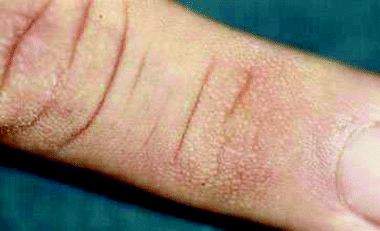Skin examination revealed diffuse xerosis and a rough, sandpaper-like appearance of the finger skin consisting of multiple, small, hyperkeratotic papules grouped in a miniature "cobblestone" pattern on the dorsum of the distal phalanges, more densely over the knuckles and interphalangeal joints. Pruritus is usually absent. A complete examination of the patient may reveal other dermatologic findings often associated with diabetes mellitus (granuloma annulare and necrobiosis lipoidica).
The diagnosis is mainly based on the clinical presentation.
Histologically, finger pebbles are the result of increased collagen in the dermal papillae.
Lab tests:- Glycated hemoglobin (A1C) test
- Blood glucose level
- Papular mucinosis
- Knuckle pads
Treatment consists of controlling the underlying disease.

